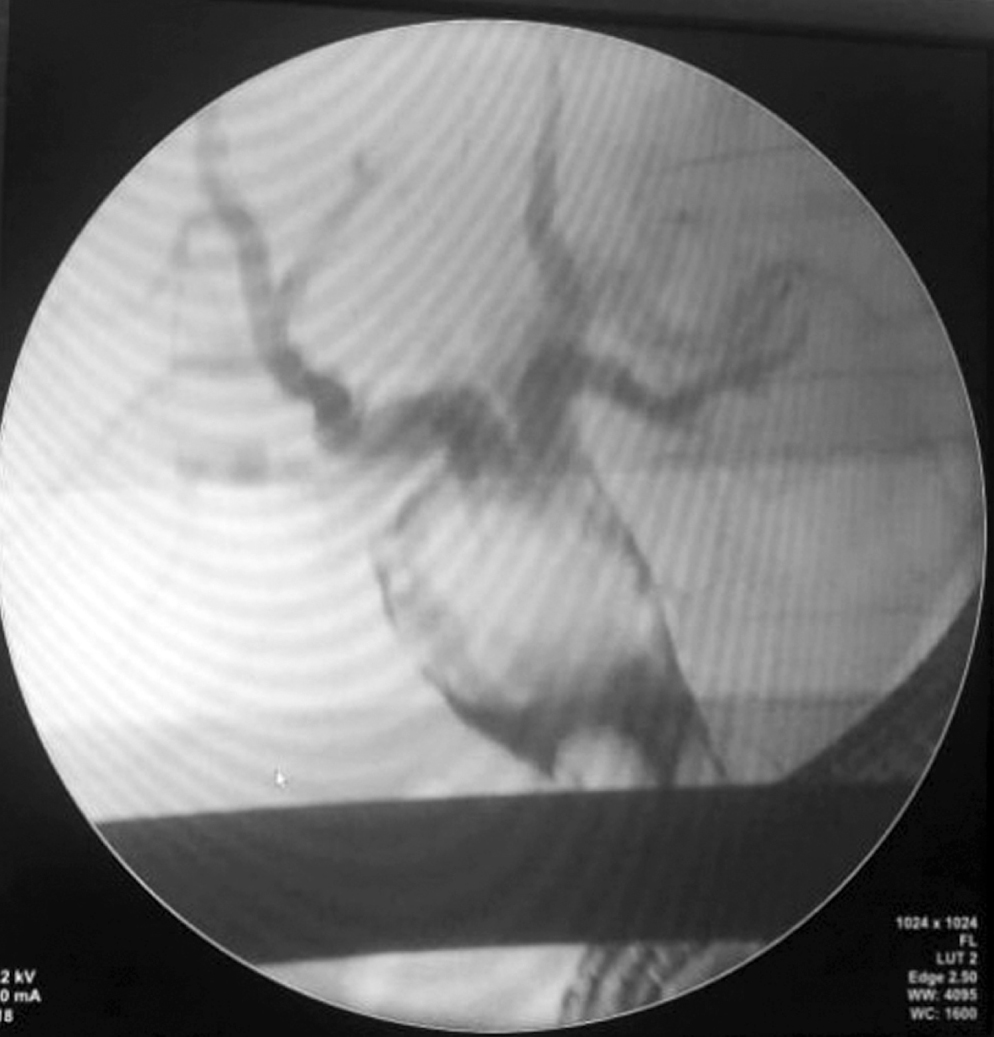Hemobilia, una causa infrecuente de hemorragia del tracto digestivo superior
DOI:
https://doi.org/10.22516/25007440.626Palabras clave:
Hemobilia, sangrado gastrointestinal, vía biliarResumen
La hemobilia es una causa poco frecuente de hemorragia del tracto gastrointestinal superior. La principal etiología es de origen iatrogénico y la posibilidad de hemobilia debe considerarse en cualquier paciente con hemorragia gastrointestinal y un historial reciente de procedimientos hepatobiliares. Otras causas menos frecuentes incluyen el trauma de abdomen, la enfermedad oncológica de la vía biliar o las enfermedades inflamatorias del páncreas o la vía biliar. La presentación clínica varía según la gravedad del sangrado; generalmente se presenta con dolor abdominal, ictericia y melenas, aunque puede cursar al ingreso con rectorragia e hipotensión. Un alto porcentaje de estas presenta resolución espontánea, sin requerir procedimientos adicionales. La angiografía es el estándar de oro para el diagnóstico de la hemobilia, pero los avances en la angiotomografía permiten que esta sea una opción menos invasiva y con mayor disponibilidad. La angioembolización es el tratamiento principal para estos pacientes, pero existen otras alternativas como la colocación de stent vascular o de stent en el conducto biliar.
Descargas
Referencias bibliográficas
Trombatore C, Scilletta R, Bellavia N, Trombatore P, Magnano S Lio V, Petrillo G, et al. Acute hemobilia from a pseudoaneurysm of the cystic artery arising from the left hepatic artery: Case report and literature review. Int J Surg Case Rep. 2017;37:60-64. https://doi.org/10.1016/j.ijscr.2017.06.014
Yopp A. Hemobilia and bilhemia. En: Blumgart LH (editor). Surgery of the liver, biliary tract and pancreas. 5.a edición. Filadelfia: Elsevier; 2012. p. 1067-81. https://doi.org/10.1016/B978-1-4377-1454-8.00105-3
Baillie J. Hemobilia. Gastroenterol Hepatol (N Y). 2012;8(4):270-2.
Hidalgo F, Narváez JA, Reñé M, Domínguez J, Sancho C, Montanyà X. Treatment of hemobilia with selective hepatic artery embolization. J Vasc Interv Radiol. 1995;6(5):793-8. https://doi.org/10.1016/s1051-0443(95)71187-3
Chin MW, Enns R. Hemobilia. Curr Gastroenterol Rep. 2010;12(2):121-9. https://doi.org/10.1007/s11894-010-0092-5
Green MH, Duell RM, Johnson CD, Jamieson NV. Haemobilia. Br J Surg. 2001;88(6):773-86. https://doi.org/10.1046/j.1365-2168.2001.01756.x
Merrell SW, Schneider PD. Hemobilia--evolution of current diagnosis and treatment. West J Med. 1991;155(6):621-5.
Sandblom P. Hemorrhage into the biliary tract following trauma; traumatic hemobilia. Surgery. 1948;24(3):571-86.
Luu MB, Deziel DJ. Unusual complications of gallstones. Surg Clin North Am. 2014;94(2):377-94. https://doi.org/10.1016/j.suc.2014.01.002
Yoshida J, Donahue PE, Nyhus LM. Hemobilia: review of recent experience with a worldwide problem. Am J Gastroenterol. 1987;82(5):448-53.
Gandhi V, Doctor N, Marar S, Nagral A, Nagral S. Major hemobilia--experience from a specialist unit in a developing country. Trop Gastroenterol. 2011;32(3):214-8.
Murugesan SD, Sathyanesan J, Lakshmanan A, Ramaswami S, Perumal S, Perumal SU, et al. Massive hemobilia: a diagnostic and therapeutic challenge. World J Surg. 2014;38(7):1755-62. https://doi.org/10.1007/s00268-013-2435-5
Casazza I, Guglietta MA, Argento G. Magnetic resonance cholangiopancreatography in the diagnosis of haemobilia. Case Rep Radiol. 2013;2013:792109. https://doi.org/10.1155/2013/792109
Prasad TV, Gupta AK, Garg P, Pal S, Gamanagatti S. Minimally invasive image-guided interventional management of Haemobilia. Trop Gastroenterol. 2015;36(3):179-84. https://doi.org/10.7869/tg.280
Cao H, Liu J, Li T, Cao G, Xu G, Zhai S, Xue J, Wang Z, Shi S, Bai W. Interventional therapy for the treatment of severe hemobilia after percutaneous transhepatic cholangial drainage: a case series. Int Surg. 2013;98(3):223-8. https://doi.org/10.9738/INTSURG-D-13-CC194

Descargas
Publicado
Cómo citar
Número
Sección
Licencia
Aquellos autores/as que tengan publicaciones con esta revista, aceptan los términos siguientes:
Los autores/as ceden sus derechos de autor y garantizarán a la revista el derecho de primera publicación de su obra, el cuál estará simultáneamente sujeto a la Licencia de reconocimiento de Creative Commons que permite a terceros compartir la obra siempre que se indique su autor y su primera publicación en esta revista.
Los contenidos están protegidos bajo una licencia de Creative Commons Reconocimiento-NoComercial-SinObraDerivada 4.0 Internacional.


















